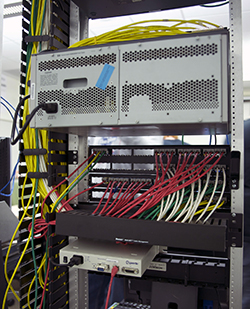
When Humboldt State’s bandwidth expansion is completed this summer, campus Internet speed will increase by 10 times its current rate, improving from one gigabit per second to 10 gigabits per second. What that means for all users is a less-clogged connection to the digital world.

“We’ve been at one gigabit for years now,” said Josh Callahan, HSU Director of Enterprise Technology. “As a campus, we are doing so much more online now, and having the higher bandwidth will both streamline what is currently being done and allow for expanded uses in the future.”
Long-standing applications like Peoplesoft consume more bandwidth as they evolve, plus additional applications that communicate across the Internet are being added to HSU's operations. But it's student usage that demands an exponential increase in bandwidth every year.
“The biggest problem we experience now is the residence hall, where we have 2,000 students butting up against the limits of what we need to have to keep the rest of the campus working,” Callahan said. “Everyone’s expectation of Internet use has changed. There are so many more services being used, like streaming high definition video. Everything is being done online, and it’s been tough to keep up.”
Improved Internet infrastructure in Humboldt County has been key to making the jump to higher bandwidth. Before 2012, only one fiber optic pathway connected HSU to the outside world, but when a redundant network linking the coast to the central valley was installed, Humboldt State’s opportunity to join the California State University’s expanded broadband efforts materialized.
Individual users engaged in the day-to-day business of managing university operations may not notice a significant change to their current Internet-related tasks, but the bandwidth expansion will prevent many of the problems they would have experienced in the near future as the demands increase.
“What it provides is more room to handle the capacity,” Callahan said. “Faculty or staff might notice a difference when moving a large file to their Gmail account because the network won’t be throttled by lots of people doing that at the same time. More important, the bandwidth allows our resources to keep up with rapidly increasing demands.”
While the HSU upgrades are underway, campus users will experience only minor inconvenience as the installation crew moves from building to building. Down time will be minimized by the installation of a parallel core prior to switching over from the previous network.
ITS plans to publish a calendar of specific dates and approximate durations for outages, and will work to keep employees notified shortly before each set of outages.